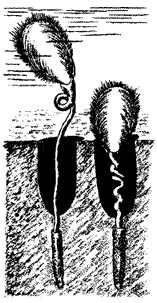
Barroisella, an extinct cousin of the living Lingula
Superfamily Linguloidea (Early Cambrian-Recent)
family Lingulidae Menke, 1828
| Linguliformea | ||
| Brachiopoda | Lingulida |
| Metazoa | Metazoa | Metazoa | ||||
| Time |
|
Brachiopoda
├─Linguliformea
│ ├─Paterinida
│ └─Lingulata
│ ├─Lingulida
│ └─Acrotretida
│ ├─Discinida
│ └─Acrotretoidea
└─┬─Craniiformea
└─Rhynchonelliformea
|

Barroisella, an extinct cousin of the living Lingula
Superfamily Linguloidea (Early Cambrian-Recent)
family Lingulidae Menke, 1828
Lingulids are shallow burrowing infaunal filter feeders of the shallow intertidal zone. The shell is chitinophosphatic, and characteristically shaped like a fingernail. Lingulids have a muscular pedicle which extrudes out from the posterior of the shell, between the valves, and a number of lateral muscles for manipulating their valves. The animal burrows by arching its pedicle up to force the anterior portion of the valves down. It then contracts the lateral muscles in sequence to move the valves back and forth in a scissors-like motion, thus burrowing down into the sediment. It remains with the anterior portion of the shell pointed up, and the vulnerable pedicle safely buried in the sediment, helping to anchor the animal.
The Lingulacea range from the Early Cambrian to Recent. Although occurring in normal marine environments, their fossil remains are much more common in shaley beds probably laid down in poorly oxygenated brackish waters, ill-suited for most marine invertebrates. In this environment, the group has maintained itself as "living fossils" with virtually no change in external form down to the present day.
 Lingulella davisi Furongian Epoch |
Lingulids appeared in the Tommotian epoch (earliest Cambrian) with Lingulella (left). During the Cambrian period they were an important component of the brachiopod faunas. It does not appear that these early representatives could burrow as well as the extant genus Lingula. Forms very similar to that genus appeared during the Ordovician period and Lingula continues to the present day. Lingula differs markedly from earlier forms in the nature of the posterior of the valves, and most obviously in the major reduction of the pseudointerareas. |
page uploaded 7 June 2002
checked ATW060125, slightly revised MAK120107
(originally uploaded on Kheper site uploaded 11 May 1999)
page by M. Alan Kazlev (Creative Commons Attribution license) 1999-2002